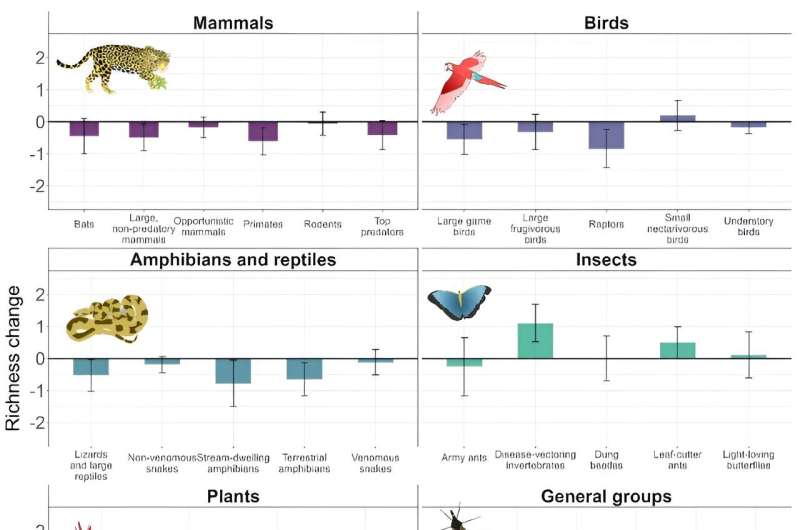This article has been reviewed according to Science X's editorial process and policies. Editors have highlighted the following attributes while ensuring the content's credibility:
fact-checked
peer-reviewed publication
trusted source
proofread
Researchers identify human activities as drivers of biodiversity decline in central Mexico's reserves

New research shows the diversity of plant and animal life in 14 tropical reserves in Mesoamerica has plummeted since 1990 as roads and cattle ranches have expanded into protected areas. Large mammals, birds, and reptiles are disappearing, while disease-carrying insects and rodents are on the rise.
Even these highly protected areas are seeing the array of plant and animal life follow a now global trend in which a few groups thrive and proliferate in human-altered landscapes where most groups decline.
"We had an idea that this was happening globally. The surprising thing is the omnipresence of this phenomenon of winners and losers in tropical areas," said senior study author Rodolfo Dirzo, a professor of biology in the Stanford School of Humanities and Sciences, and of Earth system science in the Stanford Doerr School of Sustainability. "This is critical because tropical rainforests are the most important stores of biological richness on the planet."
The research is based on surveys of more than 60 tropical ecologists who, like Dirzo, have spent decades studying reserves in central Mexico. The 14 studied reserves, which are part of a biodiversity hotspot that spans across Mesoamerica, have each been designated under a UNESCO program aimed at establishing a scientific basis for improving human livelihoods and safeguarding ecosystems.
In and around many of the protected areas, the authors found that new roads continued to go up and trees came down between 1990 and 2020 as people cleared forest for timber or cattle grazing. The abundance of long-lived, shade-tolerant tree species—the kind that make old-growth forests some of our planet's largest carbon sinks—declined on average across all reserves by more than 25%.
"What is left is just small pieces of forest, and then a lot of disturbances around them," said lead study author Daniel Auliz-Ortiz, who worked on the research as part of his doctoral thesis at Universidad Nacional Autónoma de México in Morelia, Mexico.
According to the study, published Jan. 22 in the Proceedings of the National Academy of Sciences, the fragmented and depleted habitats that remain do not sustain populations of primates, many butterflies, raptors, reptiles, amphibians, and apex predators like jaguars in the numbers they once did. In their place, small, rapidly reproducing animals like rats and mice and weedy, light-loving vines have flourished.
A global challenge
The changes unfolding in central Mexico's tropical forest reserves illustrate a reality of protected areas around the world: Deforestation is rarely eliminated entirely, with major negative consequences for ecosystems and humans.
Small rodents carry many infectious diseases that can spread and prove dangerous to people. As prolific seedeaters, they can also change where and how various plants become established in an ecosystem, added Dirzo, who is a senior fellow at the Stanford Woods Institute for the Environment and the Bing Professor in Environmental Science. "We are positioning them to be the winners in these ecosystems," he said.
Also among the winners are fast-growing, pioneering plants that need abundant light and can take advantage of disturbed or clear-cut landscapes, but which store much less carbon than the shade-tolerant tree species they are replacing. This replacement "can significantly limit global carbon storage," the authors write.
Expanding opportunities
To prevent further deforestation, the researchers call for expanding opportunities for people to earn a living around protected areas by means other than cattle ranching. They found that forest loss rates were lower and human welfare was higher in regions where economies revolve around alternatives such as eco-friendly tourism, public programs that pay local communities for the environmental services provided by intact forests, or cultivation of multiple crops like coffee and cacao under the shade of a forest canopy.
In the absence of these opportunities, the researchers found local communities often turn to intensive cattle ranching or monoculture farming—and are forced to cultivate more and more land to remain profitable.
"Protection is not a panacea," said Dirzo. "We need to make sure that the areas we have set aside are not just reserves on paper, but that they're effectively safeguarding biodiversity within landscapes where the livelihoods of local peoples are also meaningfully supported."
More information: Daniel Martín Auliz-Ortiz et al, Underlying and proximate drivers of biodiversity changes in Mesoamerican biosphere reserves, Proceedings of the National Academy of Sciences (2024). DOI: 10.1073/pnas.2305944121
Journal information: Proceedings of the National Academy of Sciences
Provided by Stanford University


















